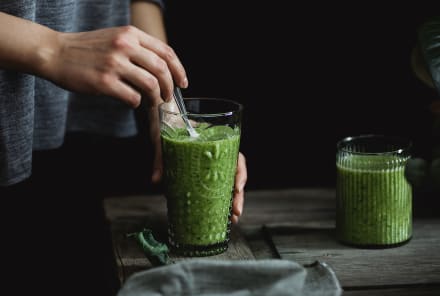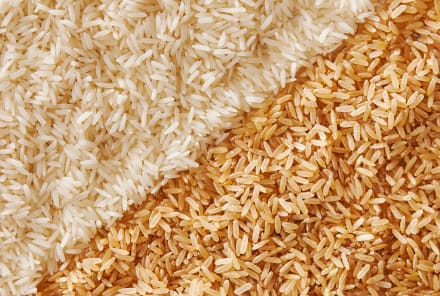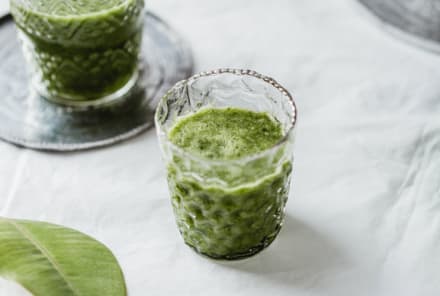Advertisement
Amaranth: Health Benefits, What It Is & How To Cook With This Ancient Grain


We're all about trying new and upcoming food trends, but we never forget the oldie-but-goodie staples of a balanced diet. Though it may not be going viral or turning heads on supermarket shelves, amaranth is a nutritionally packed powerhouse that deserves some recognition.
We tapped two registered dietitians to get the scoop on amaranth: What it is, why it's nutritionally beneficial, and how to eat it.
What is amaranth?
According to registered dietitian Elise Harlow, M.S., RDN, amaranth is a plant that originated in Central America, and its cultivation dates back to Inca, Maya, and Aztec civilizations.
"The seeds are considered to be part of the grain family and are one of the six pseudocereals," Harlow says. Pseudocereals are a plant that produces a seed or fruit that is consumed as a grain—others include quinoa, buckwheat, and chia seeds. So even though it's labeled a grain, if we're being technical, amaranth is a seed.
"Amaranth was used widely by the Aztecs as not only a food staple but also as part of their cultural and religious rituals," says Sarah Jackson, M.S., RDN, of Origin Nutrition. "Today, amaranth is mainly produced in China but is also grown in Mexico, Central America, and areas in the United States.
The seeds themselves are itty-bitty, similar to the size of a poppy seed, and they are light tan and beige colored. Although amaranth can appear in sweet or savory recipes, it does have a potent flavor that makes it difficult to camouflage in some dishes. Expect a nutty taste, grassy scent, and hints of herby flavor.
8 benefits of amaranth:
It's full of manganese.
"Just 1 cup of cooked amaranth contains over 105% of the recommended daily intake for manganese, an essential trace mineral," Jackson says. She adds that manganese is an important component of the antioxidant enzyme superoxide dismutase, which is a big scientific term for a system that fights free radicals in the body. "It's also responsible for helping to keep our joints healthy," she notes.
It's a great plant-based protein.
"Unlike many grains, amaranth is a complete protein," Jackson says, which means it contains all nine essential amino acids, including lysine, which is typically lacking in most grains. In fact, 1 cup of cooked amaranth contains 9.3 grams of protein1, which is more than double rice's 4.3 grams2.
It's full of fiber.
Fiber is essential for healthy digestion and regularity, plus it helps keep you fueled and satiated for longer. With 5 grams of fiber per cooked cup, Jackson says amaranth is also a good source of dietary fiber.
It may help manage blood sugar
In addition to manganese being an essential trace mineral, Jackson says it's also been shown to assist in carbohydrate metabolism and blood sugar regulation.
While the direct role of amaranth in blood sugar has also primarily only been studied in rats3, the high fiber and protein content indicate that the grain may also help balance blood sugar in humans, too.
It supports healthy bones.
One cup of cooked amaranth boasts 116 milligrams of calcium, according to the USDA. Calcium plays a vital role in bone and teeth health and flexibility of muscles. (Pro tip: Vitamin D helps boost calcium absorption, so pair the two together when possible.)
It may help manage inflammation.
"Amaranth contains a polypeptide called lunasin, which is believed to decrease inflammation in the body4," Jackson says.
It supports a healthy skin barrier (& more).
Squalene is most recognized for its ability to not only moisturize the skin but also promote a healthy skin barrier. "It's known to combat damage to the skin caused by aging and promote collagen levels," Jackson explains.
However, squalene isn't just a topical hero: This oil is also found in some foods, including amaranth. And according to Jackson, eating squalene has its own health benefits. "This phytonutrient has been studied for its beneficial effects on cholesterol levels5," she says. Which brings us to our next point:
It may help lower cholesterol.
Squalene doesn't act alone when it comes to the cholesterol benefits of amaranth. "Several studies have shown that amaranth can lower cholesterol," Harlow says. "This effect has been attributed to its unsaturated fatty acid, soluble fiber content, and phytosterols."
How do I incorporate this grain into my diet?
Thankfully, there are a few ways to incorporate amaranth into your diet. You can eat it in its whole form or ground as a flour. It's a naturally gluten-free grain, so people with gluten sensitivities or celiac disease can eat it safely. Jackson does warn that if you choose to use amaranth flour, you'll want to mix it with another type of flour, such as wheat, rice, or tapioca, to make it suitable for leavened breads. The blend will also mellow out the nutty flavor of amaranth, making it more palatable and less grainy.
To cook amaranth, you'll use a method similar to cooking rice. "Amaranth cooks best with a ratio of one and a half cups of liquid to half a cup dry amaranth," Harlow suggests. You will boil the water, add the grain, and cook it until the liquid is absorbed into the grain, which is about 20 minutes.
Jackson says a few go-to ways to include amaranth is to use it as a natural thickener for stews, soups, and chilis. "It also makes a highly nutritious breakfast porridge if simply cooked and topped with nuts, fruit, and honey."
We love amaranth in a chocolatey, coconutty breakfast dish like this mood-boosting breakfast bowl. Or add a scoop of amaranth to a salad like this tuna Niçoise variety. Or if you want to keep it plain and simple, serve a cup of this grain alongside your favorite protein and veggie for a nutritionally dense dinner. The options are endless!
The bottom line.
Amaranth might date back thousands of years, but its nutritionally rich profile hasn't faded. It's a complete protein, plant-based, and fiber-rich—among other nutritional benefits. This pseudocereal can be used in countless ways and added to just about any meal of the day.
Watch Next
Enjoy some of our favorite clips from classes
Enjoy some of our favorite clips from classes
What Is Meditation?
Mindfulness/Spirituality | Light Watkins
Box Breathing
Mindfulness/Spirituality | Gwen Dittmar
What Breathwork Can Address
Mindfulness/Spirituality | Gwen Dittmar
The 8 Limbs of Yoga - What is Asana?
Yoga | Caley Alyssa
Two Standing Postures to Open Up Tight Hips
Yoga | Caley Alyssa
How Plants Can Optimize Athletic Performance
Nutrition | Rich Roll
What to Eat Before a Workout
Nutrition | Rich Roll
How Ayurveda Helps Us Navigate Modern Life
Nutrition | Sahara Rose
Messages About Love & Relationships
Love & Relationships | Esther Perel
Love Languages
Love & Relationships | Esther Perel












